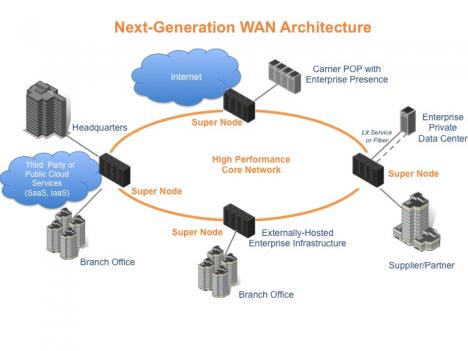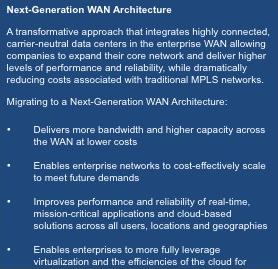This article was originally published on CloudComputing.Sys-Con.com on June 2, 2013.
Companies are transforming their Wide Area Networks to more quickly and efficiently fuel their move to the cloud
It’s clear that cloud computing has transformed the enterprise IT landscape, from the computing infrastructure layer up through enterprise software, as companies move to leverage more efficient and cost-effective service-delivery models and bring new cloud-based products and services to the market. Perhaps less known is the innovation taking place at the network level and how leading companies are transforming their Wide Area Networks (WAN) to more quickly and efficiently fuel their move to the cloud.
Moving to the cloud requires network managers and IT shops to implement scalable solutions that ensure the reliability and performance of cloud-based applications across their extended enterprise. Cloud computing drives the need for more reliability across the WAN and ever-increasing amounts of highly available, secure and reliable bandwidth across all users, locations and geographies. However, many enterprises are constrained by their existing network infrastructure, both from a cost and performance perspective. They can’t cost-effectively scale their networks; and latency, jitter and packet loss impact performance and reliability in the cloud.
Transforming to a next-generation WAN architecture plays a critical role in enabling enterprises to more easily and cost-effectively migrate to and better support public, private and hybrid cloud environments.
According to Forrester, ‘enterprise use of the cloud has arrived,’ with nearly half of all companies in North America and Europe setting aside budget for private cloud investments in 2013. Legitimate budgeting to integrate cloud services into existing platforms and deploy software apps to the cloud confirm that IT shops are ‘no longer denying it’s happening in their company.’ Increasingly, enterprises are moving beyond their own data centers to leverage infrastructure and applications, choosing to host their own applications externally or leverage services from third-party providers.
Cloud infrastructure providers, such as Amazon and Rackspace, are well established in the enterprise IaaS market delivering compute, storage and hosting services to businesses of all sizes from SME to large multi-national corporations. Since its launch in 2006, Amazon Web Services’ (AWS) S3 offering has grown to encompass more than two trillion objects stored and company revenues have grown past $2 billion.[1] AWS clearly dominates the cloud platform space holding as much as 70 percent of the market, with its enterprise clients spending anywhere from $12,000 to $2.5 million per year on its infrastructure services. The push of traditional companies such as Microsoft, IBM and HP, as well as and a host of other players, into this space further validates the arrival of cloud in the enterprise market.
On the software side, service providers like Salesforce.com have been offering cloud-based enterprise software for years, enabling companies to optimize their costs under a pay-per-use model, while simplifying the delivery of reliable apps that scale more easily. According to the Aberdeen Group[2], SaaS is becoming an increasingly important deployment model for enterprise applications, with highest adoption among CRM and ERP solutions. Nearly 80 percent of all companies are currently using at least two or more SaaS applications and many have reported decreased spending on application deployment resulting from SaaS usage.
Enterprises will continue to use a range of cloud solutions, developed internally and sourced from external providers, to more efficiently and effectively distribute mission-critical applications on a global scale. Most will need to move beyond their traditional legacy networks to ensure higher levels of performance, reliability and scalability of these applications across the WAN.
Traditional WAN Design and Optimization Approaches: Falling Short in the Cloud
Cloud is causing an explosion in enterprise bandwidth and making traditional WAN management obsolete. Bandwidth demands will continue to grow and the enterprise WAN will continue to need more bandwidth. While the actual services delivered are the main attraction in the cloud, enterprises are finding that traditional Multiprotocol Label Switching (MPLS) networks and WAN acceleration technologies can’t keep up.
Migrating to the cloud has put new pressures on WAN connectivity, from both a cost and performance perspective. Existing networks and optimization solutions cannot provide the capacity, reliability and scalability required across all users, locations and geographies. Work environments and application needs have changed, and will continue to change dramatically. In many cases, network design has become a limiting factor with reliance on traditional architectures that have not been optimized to support how applications are being hosted and accessed in public, private and hybrid cloud environments, or how and where people work.
Traditional WAN architecture is based on a hub-and-spoke model with data distributed from headquarters to branch locations and across centers (DC2DC) connected via public and private networks. At the branch or edge locations, sites are connected via low bandwidth MPLS links often over T1 to DS3 access links from the local telco. Connectivity across larger more bandwidth-intensive sites, such as corporate HQs and data centers, use expensive MPLS WAN links configured in a higher bandwidth core, typically in the range of 100Mbs.
The majority of enterprise WAN links are high cost, site-to-site private MPLS lines sourced from incumbent telcos like Verizon and AT&T. As enterprise bandwidth demands increase, the high cost of MPLS-based WAN connectivity and the complexity of underlying networks impact the enterprise’s ability to cost-effectively scale their networks with the growth in demand.
Not only is the enterprise use of global MPLS for “backbone” traffic becoming less cost competitive as scale increases, but it is increasingly challenging to control costs associated with real-time applications, distributed cloud services and rich media. Traditional network topologies can also limit an enterprise’s ability to fully leverage infrastructure and server virtualization as a means to more effectively distribute enterprise applications across all locations and users, and application performance suffers over long distance network paths. Furthermore, as enterprises seek to leverage solutions sourced from external providers, using MPLS as the connectivity method to SaaS and other public cloud locations is not agile enough and doesn’t scale effectively given the high cost per bit.
MPLS is not the only factor driving the need for enterprises to rethink their networks. The public Internet is becoming an increasingly important distribution medium to reach customers and stakeholders, but managing performance is becoming critical.
While the Internet provides ease of access across a broad base of users, it often lacks the performance and reliability required to support mission-critical, cloud-based enterprise solutions. Packet loss and jitter are more common across the Internet than MPLS; and network congestion and latency vary across locations and geographies as no single provider can guarantee end-to-end performance. Nevertheless, accessing services via the Internet is a reality, and it is increasingly important for enterprises to architect network solutions that best optimize “public” access to cloud-based apps and services.
Another approach enterprises have used to optimize the performance of business-critical applications over the enterprise network has been through WAN optimization. Traditional WAN optimization techniques use appliances and hardware installed at corporate and remote locations to improve end-to-end application performance by increasing data-transfer efficiencies across wide-area-networks. These technologies are often application or protocol-specific and seek to optimize how individual applications work over the WAN instead of making the WAN work better for all applications.
While these appliances have helped deliver better application performance, this approach tends to be more tactical in nature, rationing a limited supply of bandwidth instead of addressing the organization’s more strategic need to add more bandwidth or capacity to support ever-increasing demands. As more applications and services are deployed to the cloud, and more bandwidth-intensive applications and real-time data are delivered across the extended enterprise, the enterprise’s demand for bandwidth will continue to increase.
Furthermore, while traditional WAN optimization solutions are dual-sided with one box at a data center and another at a branch office, this approach to optimize cloud applications can only be implemented with a single-sided solution since an appliance cannot be placed in front of an application residing in the cloud. As such, traditional solutions can fall short in the cloud, and are better suited for improving the performance of non-real-time applications, such as email, network backup and remote file access.
Rethinking Enterprise Networks: Next-Generation WAN Architecture
Enterprises that wish to leverage private, public or hybrid cloud solutions to distribute data and applications across a country or around the globe need to rethink their WAN architecture to achieve the required scale within existing budgets. Bandwidth economies of scale between highly connected network aggregation points offer exponential improvements in bandwidth availability at a fraction of the cost, but most enterprises are unaware of how to tap into these aggregation points or even that they exist.
The first step is connecting existing enterprise data centers and the WAN directly into carrier-neutral data centers that are “highly connected” and provide direct access to wide array of high capacity, high bandwidth connectivity options, as well as a growing base of cloud infrastructure and application providers.
These carrier-neutral data centers, operated by providers such as Equinix and Telx, are well known for outsourced IT services, including data center colocation, managed hosting of external-facing websites and applications, proximity to public cloud services, and as secondary sites for disaster recovery and business continuity. However, many enterprises are less familiar with these facilities as a key enabler of a high performance, next-generation WAN architecture.
Integrating these facilities as “super nodes” in the WAN provides enterprises a long-term approach to increase control over performance, reliability and scalability for the cloud while providing a means to significantly drive down bandwidth costs.

Carrier-neutral facilities are centrally located and provide enterprises broad access to competitive carrier markets with a near limitless supply of diverse, inexpensive bandwidth from Tier-1 and Tier-2 network carriers. By leveraging these facilities, enterprises are no longer constrained by the incumbent telcos and their legacy networks and have direct access to fiber and bandwidth from competitive providers at prices much lower than MPLS along with a wider array of MPLS and similar services.
Re-architecting existing networks to a next-generation WAN architecture provides a means to more cost-effectively scale the WAN to grow with the enterprise’s demands than traditional MPLS-dense, hub-and-spoke networks. Additionally, bandwidth can easily be added at lower cost, secure hosting or rack space for new hardware or software can be deployed, and latency performance can be improved by connecting additional proximity locations.
Beyond the cost and scalability benefits of network transformation, by building out a higher performance core network integrating super nodes and direct fiber connectivity, enterprises can substantially improve performance and reliability of virtualized, networked and cloud-based solutions, both for intranet applications as well as SaaS and cloud-based services.
Carrier-neutral, data centers often serve as network access points or public peering locations, close to the core of the Internet and public cloud services. Moving closer to the Internet core enables more reliable access to third party SaaS, IaaS and other cloud-based services, even delivering close to “on-net” reliability of cloud services located at the same colocation facility. Furthermore, these facilities are often close, in terms of latency, to a large number of users and businesses connecting to the Internet, enabling more reliable access and service delivery to a broader base of users.
 This architectural approach can provide better performance and help to address several of the key WAN factors affecting application performance while delivering enhanced end-to-end network performance, speed and reliability. A next-generation WAN architecture sets the foundation to enable enterprises to better leverage the power of virtualization and gain the efficiencies of the cloud to more effectively distribute enterprise applications and services. A higher performance core network connecting corporate data centers and third-party facilities with more robust WAN connectivity allows enterprises to take advantage of bandwidth costs and application performance benefits today, while providing the ability to cost-effectively scale to meet future demands.
This architectural approach can provide better performance and help to address several of the key WAN factors affecting application performance while delivering enhanced end-to-end network performance, speed and reliability. A next-generation WAN architecture sets the foundation to enable enterprises to better leverage the power of virtualization and gain the efficiencies of the cloud to more effectively distribute enterprise applications and services. A higher performance core network connecting corporate data centers and third-party facilities with more robust WAN connectivity allows enterprises to take advantage of bandwidth costs and application performance benefits today, while providing the ability to cost-effectively scale to meet future demands.
This next-generation WAN architecture is the exact approach that today’s leading companies are using to transform their global WAN architectures around highly connected aggregation points or “super nodes”. Moving from legacy MPLS networks, these companies are building out their own high capacity, highly connected core backbones, and pushing MPLS to the edge. Once connected to the right network aggregation points, bandwidth costs begin to fall rapidly while bandwidth increases and access to cloud-based infrastructure and applications is streamlined and simplified.
CFN Services works with leading companies to map their legacy WAN to this new cloud world order. To learn more about CFN’s network transformation solutions and how next-generation WAN architecture can improve business performance, please visit www.cfnservices.com
Gain additional insights on how leading organizations are utilizing smarter networking strategies to improve network and application performance in the Aberdeen Group’s “Building a Smarter Networking Strategy for the Modern Large Enterprise” white paper.
References:
- Cloudyn, AWS Client Research
- The Growing Importance of SaaS as an Application Deployment Model, Aberdeen Group, March 1, 2013

